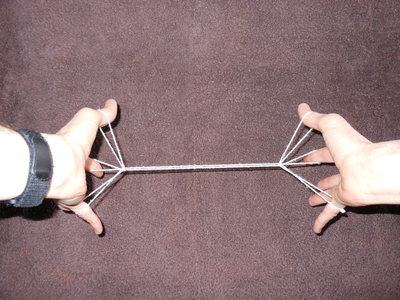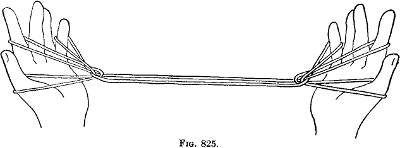

LLX > Neil Parker > String Figures > Jayne


1. Opening A, but using middle fingers intead of indexes.
2. Transfer thumb loops to indexes.
3. Pass thumbs away from you under all strings, and pick up far little finger string, and return under all strings.
4. Pass thumbs over index loops, and under middle finger loops, pick up near little finger strings, and return under middle finger loops..
5. Lift lower thumb loops up past upper thumb loops and off the thumbs, and drop.
6. Release middle finger loops.
Before I leared of Dr. Gordon's field notes, I had come up with the reconstructions below, the first two of which give results that differ in only a few minor ways from the actual figure:
First reconstruction:
1. Opening A.
2. Transfer index loops to middle fingers, and thumb loops to indexes.
3. Pass thumbs away from you under all strings, and pick up far little finger string, and return under all strings.
4. Pass thumbs over near index strings, and pick up far index strings.
5. Lift lower thumb loops up past upper thumb loops and off the thumbs, and drop.
6. Release middle finger loops.
Second reconstruction:
1 through 3. The same as steps 1 through 3 of the preceding method.
4. Press thumbs down on near index string, and keeping that string on the palms of the thumbs, pass thumbs under index and middle finger strings, and up between far middle finger strings and near little finger strings.
5. Turning thumbs toward each other, and then toward you, pick up on their backs the near little finger strings, and pull them forward between near and far thumb strings, which slip off. Return under middle and index strings.
6. Release middle finger loops.
To dissolve either of these figures without tangles, release thumb loops.
Neither of these methods gives entirely satisfactory results - the first method tends to come out with the index loops too short, and the second method tends to come out with the little finger loops too short. (The photograph is of the results of the second method.)
Here's a way to get much better, and more stable, toes for the feet. Unfortunately it doesn't start with opening A, and its string crossings clearly don't match Jayne's illustration:
1. Position 1.
2. Pass indexes away from you and down over far little finger string, and hook up far little finger string, and (with indexes still pointing down) bring them forward over near thumb string. Then give indexes a half-twist away from and up, picking up the near thumb string and allowing the little finger string to slip off.
3. Transfer index loops to thumbs.
4. The far little finger string now hooks through the thumb loops before crossing between the hands. Insert little fingers from below into the central opening, closer to the middle of the figure than the thumb loop hooks, and pick up the far little finger string.
5. With right thumb and index, reach under the hooked strings on the left palm, and draw out the straight left palmar string. Put it over the right index and return. Repeat on the other hand, drawing the right palmar string up through the right index loop.
4. There are two near thumb strings on each thumb, one of which goes straight across to the other thumb. Remove this string from the thumb and drop, leaving the other thumb loops in place.
5. Similarly, drop the straight far little finger string from the little fingers, leaving the other little finger loops in place.
6. Exchange index loops, passing left loop through right.
This method was inspired by [Lutz 1912]'s figure "Bush" (which results in four toes).
To dissolve this figure without tangles, release index loops.
For different ways to get a similar result, see the Hawaiian figure O-ko-le-a-mo. The first two reconstructions above were actually discovered by starting with the following O-ko-le-a-mo-like figure, and then working backwards to try to turn it into Opening A:
1. Position 1, but using indexes in place of thumbs.
2. Pass thumbs under loop, and pick up far little finger string, and return under near index string.
3. Pass thumbs over near index string, and pick up palmar strings. Then, bending thumbs toward each other, and then toward you, pull palmar strings between near index string and near thumb string (which slips off).
LLX > Neil Parker > String Figures > Jayne